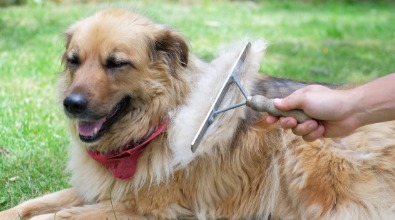Nothing compares to the joy of having a pet dog. Dogs are sweet, loyal, smart, and full of cuteness. But if there’s one thing that annoys most pet owners about their furry babies, it’s their hair scattered all around the house.
Shedding in dogs is normal and is in fact, a sign of good health. Depending on the breed and type, some dogs shed more than others do. It can also depend on the season. For instance, most dogs would develop a thick coat during the winter and shed in the spring, in preparation for the warm weather.
In this article, learn about dog shedding and what you can do to lessen the mess and frustration it brings especially this summer season. Also, learn about excessive shedding and how it can be a sign of an alarming illness or waning health in dogs.

What to Expect
Generally, dogs will shed more in the spring or fall. Seasonal shedding occurs as a result of temperature change. It is their way of coping with the changing weather – a survival mechanism.
The said process is also called “blowing coat”. Most dogs are double-coated which means they have undercoats and topcoats. The topcoat is what you see and feel on the outside when you touch your pet while the undercoat grows around the primary hair and is generally softer and shorter. As the weather gets warmer, dogs will shed their undercoats, leaving a light coat that will keep them comfortable in the summer.
How much shedding is normal?
The amount of shedding varies per dog breed. Typically, double-coated dogs shed their undercoats during the spring and fall while breeds like Labrador Retrievers, Golden Retrievers, Huskies, German Shepherds, Border Collies, and Beagles shed heavily.
Meanwhile, smaller dogs tend to shed less, such as Shih Tzus Poodles, Maltese Terriers, and Brussels Griffons. It is a great idea to always check (before adopting or buying a dog) its shedding qualities so you know if you need to worry or not when your dog seems to shed more than the usual.
What can cause excessive shedding?
While it can be completely normal for some dogs to shed a lot, abnormal shedding can also be a sign of poor health, anxiety, or stress. If you think that your dog seems to shed more than it usually does, it is always advisable to consult your veterinarian. Take note that pregnant and lactating dogs will shed more than usual.
There are many reasons why dogs shed abnormally. Among these are:
- Fungal or bacterial infectionsImmunity disorder
- Parasites
- Food allergy
- Poor nutrition
- Problems with the kidneys, liver, or adrenaline
What can you do to minimize shedding in your dog?
While shedding is something that you will have to deal with for the rest of your “pet owner” life, the good news is that you can do something to control it.
Routine grooming is the key. An important aspect of controlling pet hair is ensuring that your dog is groomed regularly. Daily brushing helps remove dead hairs before they land on your carpet, fabrics, upholstery, and on every corner of your home. Comb your dog’s fur every after giving him a bath. The use of pet dryers should make the job easier and quicker for you. Ask your veterinarian or groomer about the type of brush that is most suitable for your dog.
How can you deal with pet hair in your home?
Shedding in dogs, especially during the summer, can mean extra work for pet owners when it comes to keeping their homes clean. During the shedding season, you will likely have to double your cleaning efforts.
To make things a little more bearable, here are some tips:
- Do the brushing thing outdoors or in the garage, whenever possible. This can save you a lot of time having to deal with the pet hair mess after.
- Use slipcovers for your furniture. No one wants to sit on a couch full of pet hair. There are furniture covers specifically made for catching pet hair. They are a great investment especially if your dog sheds a lot.
- Use throw rugs to protect your floor and carpet. This helps a lot in preventing pet hair from spreading all-around your house. Choose inexpensive machine-washable rugs that you can just replace when they become stained or worn-out.
- Invest in some cleaning accessories. Tools like a lint roller make it easy to remove pet hair from clothes and fabrics while a handheld vacuum lets you clean furniture and other surfaces with ease.
Shedding is a normal process that nearly all dogs go through. While there is no magic bullet for controlling pet hair from invading your home, there are certainly effective ways, such as regular grooming and housekeeping, that should help you deal with it.





